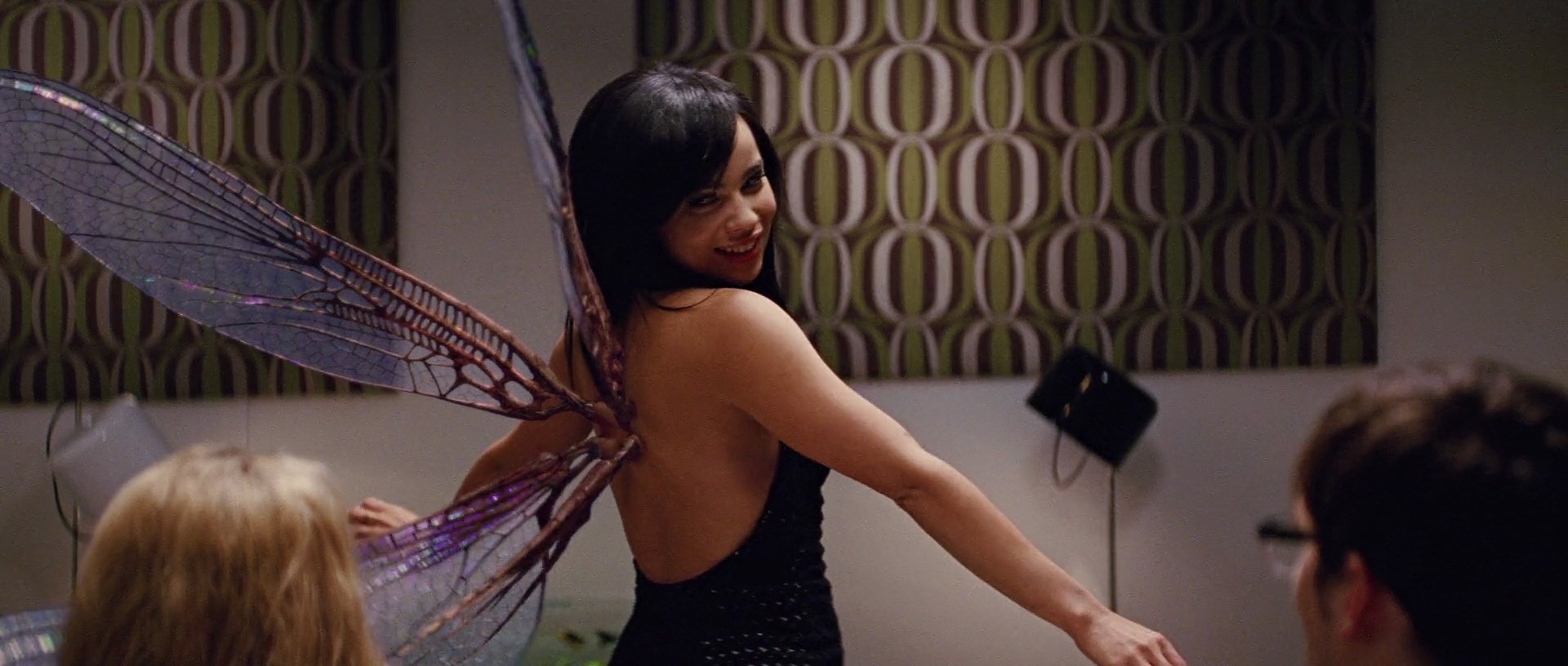[Pride 2019] Two Angels: The Mutant Body in X-Men: The Last Stand and X-Men: Days of Future Past
One of the opening scenes of X-Men: The Last Stand involves a young Warren Worthington cutting off his own wings. The bloody wounds on his back have stuck with me since I first saw the movie in the summer of 2011, first for the unexpected viscera, but now for the way this scene proves to be the exception that proves the rule.
Warren’s wings have always had an interesting relationship to the allegory of oppression as embodied in the mutant experience; while he has to hide them to pass as human, he is always presented by the narrative -- both in the comics and the two movies in which he appears -- as beautiful, and the wings are part of that beauty.
In Chris Claremont’s novelization of The Last Stand, Warren comes to the Xavier Institute after refusing the cure his father funded the development of, and Bobby Drake shows him to his new room, leading to this moment:
Upstairs, a little later, Bobby ushered Warren into a room.
“Might not be what you’re used to,” he semiapologized.
“It’s perfect,” Warren assured him.
“Yeah, Bobby nodded, comprehending the multiple meanings. “No parents.”
With just those few words, they made a connection. And from it Bobby intuited at once that Warren had a lot to process, work best done in private. Telling the new arrival he’d give a yell at dinnertime, Bobby stepped out into the hall to leave the boy alone. As he closed the door, though, he caught a glimpse of Warren flexing his wings, stretching the gleaming alabaster pinions so wide they scraped the walls of the room.
With that sight came the obvious code name for so glorious a creature, that encompassed his strength and the evident courage it must have taken to break with his father-- whom it was equally apparent the young man still loved-- and of course his unearthly beauty.
“Welcome to Xavier’s,” Bobby breathed, “Angel!”
This is one of only two times in which a physical mutation hasn’t been either relegated to a background character or to shown in contrast to the character who has it.
In X2: X-Men United, Kurt Wagner is shown to be kind and sweet despite a sad backstory, extensive ritual scarring, and a devilish appearance. In X-Men: First Class, Mystique wants someone to see her natural body as beautiful, and Hank McCoy wants to make himself appear ‘normal.’ The vast majority of mutants with physical mutations are background villains, a la Azazel, Toad, and Quill, or they die a la Blink in X-Men: Days of Future Past.
This expresses, on a subconscious level, the idea that the physical mutation, the mutation that cannot be hidden, or requires assistive technology to hide, is a drawback to one’s life at best and a marker of evil at worst.
For me, this idea is best expressed by another Angel -- Angel Salvadore, seen alive in X-Men: First Class, and whose corpse is an important factor in X-Men: Days of Future Past.
Angel can hide her physical mutation much more easily than Warren, admittedly -- her dragonfly-esque wings fold into tattoos across her shoulders -- but she comes from almost the opposite world. Warren grew up as a young, rich, white guy, with his wings the only thing divorcing him from a world that otherwise would be fundamentally on his side; Angel, on the other hand, is a Black Latina sex worker whose position in life is always precarious.
Warren dies offscreen in between The Last Stand and Days of Future Past; we only know for sure that he dies, and how it happens, from tie-in website 25moments.com, which tells us that Warren dies in 2011 during an Occupy protest.
Days of Future Past, however, goes to lengths to show us autopsy photographs of Angel’s dead body, as one of the main motivators of Mystique’s vengeance quest. Her body, alongside Azazel’s, drives Mystique to try and kill Bolivar Trask, who used their bodies in his development of his Sentinel Program -- the program that would, in-universe, eventually destroy all of mutantkind.
Additionally, we see one of Angel’s severed wings in some kind of archive or exhibit when Magneto goes looking for his anti-telepathy helmet after he’s been broken out of jail; in death, her remains aren’t even permitted to remain contiguous, much less given the respect of a burial.
Azazel and Angel aren’t the only characters Trask killed, but it is their bodies that we see photos of. While photos were taken of Banshee’s remains, those photos also only made it so far as a tie-in website, the now-defunct Bent Bullet -- Banshee’s death is not as motivating, says the narrative, in so doing.
Despite Warren’s self-mutilation at the start of The Last Stand, and both of their deaths as backstory for Days of Future Past, Angel’s body is treated very differently; she is villainized, objectified both in universe and by the narrative itself, and, worst of all:
She is never even avenged.
Mystique’s arc in Days of Future Past does end with forcing the world to recognize the existence of mutants, but it also ends with her proving to the world that mutants don’t have to be violent -- something that is key to the Xavier Politic -- and by turning her violence toward stopping Magneto rather than getting justice for her loved ones.
Angel and Azazel and Banshee and Emma and Riptide -- none of the dead get justice, because justice for them, the narrative says, would doom mutantkind forever.
I think it’s interesting that these, the most visible sacrifices, are mutants with physical mutations. I think it’s interesting especially when it’s held in contrast to the one mutant whose physical mutation gets to be narratively beautiful and heroic.
And I think it’s extremely telling that the movie that draws them into parallel is Days of Future Past, a movie about preventing the collapse of history, about changing things so that all the dead in the future have a shot at survival.
Angel’s body is shown to us, naked and dead, an object motivating a vengeance quest that goes unfulfilled. Presumably, this lack of justice for her will go on to save him.
And I think that’s very frustrating, that it has to be her, in much the same way that it’s frustrating the way that Darwin dies in X-Men: First Class. Do I think it’s racist? Effectively, yes. Intentionally? Probably not, but that doesn’t matter.
Either way, I think we have to, as an audience, interrogate the nature of the mutant body, and which mutant bodies get to be heroic, and which mutant bodies are either treated with contempt or objectification.
It will reveal some uncomfortable truths, I think, about the scaffold of assumptions on which we build our media landscape.
Murphy is a writer and cultural critic whose work always seems to come back to the X-Men. They've been published in the MNT, and run their own blog at No More Metaphors.
You should follow them on Twitter and Instagram.


![[Pride 2019] Two Angels: The Mutant Body in X-Men: The Last Stand and X-Men: Days of Future Past](https://images.squarespace-cdn.com/content/v1/5b39608d75f9eef54c62c3f0/1560028480927-8VUZWP0O88SMK2TQTC3H/thumbnailImage.jpg)





![[Pride 2021] An Ode to the Bodies that Lifted Me Up: 'Queer' Muscularity in Pop Culture](https://images.squarespace-cdn.com/content/v1/5b39608d75f9eef54c62c3f0/1622928217981-TPF2YFDN8FHIZ34L9Y57/clean.jpg)
![[Pride 2019] Tethered to the Closet](https://images.squarespace-cdn.com/content/v1/5b39608d75f9eef54c62c3f0/1560985069673-1LGBOSFI1WH4KFFN4NFV/mv5bztlinwjhm2ytndc1mc00ytk1lwe2mgytzme4m2y5oddlnzqzxkeyxkfqcgdeqxvymzy0mte3nzu40._v1_.jpg)
![[Pride 2019] Blood, Boys and Blowjobs: Revisiting 2004's Gay Slasher, Hellbent](https://images.squarespace-cdn.com/content/v1/5b39608d75f9eef54c62c3f0/1561677413349-Z8GQF3LFPP2MCPCWDIUP/tyertyretyer.jpg)
![[Pride 2019 Short Story] The Lighthouse](https://images.squarespace-cdn.com/content/v1/5b39608d75f9eef54c62c3f0/1560976351288-0HHZ6O2JR0HUSSCFQX1Q/pexels-photo-722664.jpeg)
![[Pride 2019] Horror, Fear & Identity](https://images.squarespace-cdn.com/content/v1/5b39608d75f9eef54c62c3f0/1560974283767-URCVH49ICXSUYBFM41EC/1253258.jpg)
![[Pride 2019] THE BOYS NEXT DOOR: The Homoeroticism of Fright Night and how it saved my life](https://images.squarespace-cdn.com/content/v1/5b39608d75f9eef54c62c3f0/1560968195855-AJ11PZT1NPP0A15IW2MF/fright-night-gay.png)
![[Pride 2019] The Lesbian Villain](https://images.squarespace-cdn.com/content/v1/5b39608d75f9eef54c62c3f0/1560979479014-K1CGGIB1HGL6M5XQQ8JH/asdffsdfgsdghdfghhjj.jpg)
![[Pride 2019] The Final Girl: A LGBTQ+ Representation](https://images.squarespace-cdn.com/content/v1/5b39608d75f9eef54c62c3f0/1560978597649-KMGZYFA5I02ZOMT9Q3VF/8ea179785b1649cdeefb0eb077c1bd32.jpg)
![[Pride 2019] Normalizing Queerness through Vampirism](https://images.squarespace-cdn.com/content/v1/5b39608d75f9eef54c62c3f0/1560977810654-H9UDEGT2J1L0RUV6KIJX/werwertwertwertw.jpg)
![[Pride 2019] Injecting Queer Femme Rage into "Audition"](https://images.squarespace-cdn.com/content/v1/5b39608d75f9eef54c62c3f0/1560979929151-RVBW26DNCHR5TBXC21BK/audition-1108x0-c-default.jpg)
![[Pride 2019 Short Story] Deer Wife](https://images.squarespace-cdn.com/content/v1/5b39608d75f9eef54c62c3f0/1560975199628-JF11Z4SHT75XB1A4L7DU/pexels-photo-2302802.jpeg)
![[Pride 2019] I Don't Watch Horror Movies](https://images.squarespace-cdn.com/content/v1/5b39608d75f9eef54c62c3f0/1560630982974-O3ZCRGEFNR2JOEF6N011/tKEHoKPZv3af0Pn3poaOLHOJ6NM-0.jpg)
![[Pride 2019 Short Story] Such Nice Guys](https://images.squarespace-cdn.com/content/v1/5b39608d75f9eef54c62c3f0/1560973260982-RMED56MMBWXYO52VD9Y5/pexels-photo-408517.jpeg)
![[Pride 2019] “Reclamations of Ourselves”: Ritual, Horror, and the Erotic in the work of Audre’s Revenge and Monika Estrella Negra](https://images.squarespace-cdn.com/content/v1/5b39608d75f9eef54c62c3f0/1560972375295-YKD2V1JBSYZLSXRT17IJ/dsfghsdghdsg.jpg)
![[Pride 2019] Is Jennifer’s Body the Bisexual Horror Film We Never Knew We Needed?](https://images.squarespace-cdn.com/content/v1/5b39608d75f9eef54c62c3f0/1560967347423-2I74925P8ETSI0BT7I81/jennifers-body-poster.jpg)
![[Pride 2019] Why Horror?](https://images.squarespace-cdn.com/content/v1/5b39608d75f9eef54c62c3f0/1560632665620-2J7FFX40WJU2LDRTZAJR/LATENTIMAGE6.png)
![[Pride 2019] Villainizing Queerness in Alexandre Aja’s High Tension](https://images.squarespace-cdn.com/content/v1/5b39608d75f9eef54c62c3f0/1560631689481-PWYN80K2HYST4CYIO5V6/MARIE_%2528HAUTE_TENSION%2529.jpg)
![[Pride 2019] Horror Did Not Save My Life](https://images.squarespace-cdn.com/content/v1/5b39608d75f9eef54c62c3f0/1560631362747-54XOE0TBGJXGOB8UOX8P/KE64oaAn.jpg+large.jpg)
![[Pride 2019] 18 & Gay](https://images.squarespace-cdn.com/content/v1/5b39608d75f9eef54c62c3f0/1560634045789-OSQ1W5ZSKQSGKPVAJXYW/XR11F0fT.jpg+large.jpg)
![[Pride 2019] How Horror is My Coping Mechanism](https://images.squarespace-cdn.com/content/v1/5b39608d75f9eef54c62c3f0/1560629268953-K08L1OLGI2ICS3WAI62V/F1pmQFht.jpg+large.jpg)

![[Pride 2019] Do You Sleep?](https://images.squarespace-cdn.com/content/v1/5b39608d75f9eef54c62c3f0/1558986875527-Q37PJSRVFPBZHMOFJBRW/i-like-when-measdfasdfasdfn-are-direct.jpeg)
![[Pride 2019] Embracing My Nature: Hannibal and My Gay Awakening](https://images.squarespace-cdn.com/content/v1/5b39608d75f9eef54c62c3f0/1560382782983-NN9RA658WTZFPQEK4DMR/f175ffff4188695dfbde6276a3c13244.jpg)
![[Pride 2019] How Sailor Moon Taught Me It's OK to be Queer](https://images.squarespace-cdn.com/content/v1/5b39608d75f9eef54c62c3f0/1560298136905-6NXB1NB337UZRR84MVCL/1.PNG)
![[Pride 2019] Don Mancini's Queer Inclusion](https://images.squarespace-cdn.com/content/v1/5b39608d75f9eef54c62c3f0/1558992991942-1EFIALF6MR98YNGQJ61J/Glenorglenda-e1497479115890.jpg)
![[Pride 2019] “Where’s the dick in my horror?!”: Thoughts on Queer Spectatorship and Desire in Horror](https://images.squarespace-cdn.com/content/v1/5b39608d75f9eef54c62c3f0/1558935308247-WRJM5QWQOIPH3IBE5ENJ/Hellbent-Pic-1.jpg)
![[Pride 2019 Short Story] A Bright and Bloody Becoming](https://images.squarespace-cdn.com/content/v1/5b39608d75f9eef54c62c3f0/1559090164312-FSVRI54ZX9ZUE7R9JC7Z/image1.jpeg)
![[Pride 2019] Fright Night and The Sexual Awakening of a Queer Woman](https://images.squarespace-cdn.com/content/v1/5b39608d75f9eef54c62c3f0/1559089258501-QQA99TSCU2BZVZFZUXLM/Jerry_Original.jpg)
![[Pride 2019] I'm Gay for Horror](https://images.squarespace-cdn.com/content/v1/5b39608d75f9eef54c62c3f0/1558991573629-UHWUVOMEKTH56IJ11XAS/the-changeling-1980-film-05ae6968-0ee6-4bb0-aa87-5e652d659be-resize-750.jpg)
![[Review] The Skin of the Teeth](https://images.squarespace-cdn.com/content/v1/5b39608d75f9eef54c62c3f0/1560031509231-SO0SKK6NQ8ULKOGZAYPO/MV5BZWQwYjBhNzMtZjNjOC00N2RkLWE4MzgtMWNlMTJhYTdhNjJiXkEyXkFqcGdeQXVyOTMwNDg0NDY%40._V1_SY1000_CR0%2C0%2C658%2C1000_AL_.jpg)